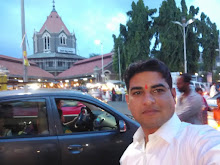In painting world, Ajanta paintings hold a very important place. Murals of Ajanta caves are one of the most vibrant, exuberant and vivacious murals in the world. Ajanta, a UNESCO World Heritage Site, is located 105 kilometers from the town of Aurangabad in the Maharashtra state of Western India. There are total 29 caves in the horse shoe shaped mountains along the ravine of Waghora river valley. These rock cut caves were dug during 2nd to 6th century BCE, predominantly for the Buddhist monks. Most of these caves were dug under the patronage of Vakataka king Harishena.
Till the beginning of 19th century, these beautiful caves were completely unknown to the world. Ajanta caves were first discovered by English Subaltern officers of Madras Army in 1819. In next hundred years, many people set out on the expeditions and collected rich and authentic information about these pristine caves. Noteworthy endeavors were put in by several western art freaks like James Alexander (1834), James Fergusson (1843), Major Robert Gill (1857), Mr. Griffith(1896), Lady Harringham (1911) and John Marshall in 1928.
Ajanta caves are actually the chaityas (sanctuaries) and viharas (monasteries), cut for the Buddhist monks. In Buddhist traditions the Bhikshus or monks had to live away from the general public in rainy seasons.
They discovered that the painting styles adopted in Ajanta were high standard murals. Art historians remain baffled to see these frescoes because to produce these frescoes a highly complex procedure had been applied and it is not a small achievement to go through that procedure at those early times. Ajanta paintings seem to have followed the rich tradition of paintings that had started during the prehistoric times at Bhimbetka, Sittanvasal and Adamgarh.
Ajanta murals are mainly didactic, devotional and ornamental in taste. Themes of the paintings are predominantly inspired from the tales of Jataka and the life and teachings of Buddha. The paintings here can be classified in to portraits, narrative illustrations and decorative ornamentation of society. Some of the most critically acclaimed paintings of Ajanta are Bodhisattva Padmapani, Miracle of Saraswati, The Dying Princess, Pillar Detail, Dark Buddha, beside the beautiful Jataka illustrations on the ceilings, walls, over the gates etc. The paintings done here give us ample information on the life style of the contemporary Indian society.
For more information on Ajanta paintings please visit http://www.ethnicpaintings.com/painting-trivia/ajanta-paintings.html
Wednesday, November 7, 2007
Subscribe to:
Post Comments (Atom)



No comments:
Post a Comment